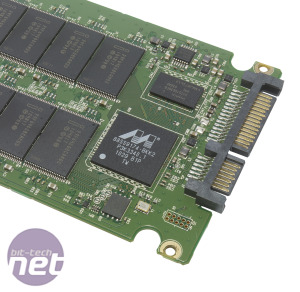Performance Analysis
In AS-SSD's sequential tests, the 510 failed to reach its rated sequential read and write speeds of 450MB/sec and 210MB/sec respectively, instead managing only 421MB/sec and 191MB/sec respectively. These might be significant increases over the speeds of the C300 128GB, but the write speed is a long way off the 287MB/sec achieved by the Crucial M4 256GB. This is the result of the Intel 510's lower density NAND modules, and is an issue across all drives that use the Marvell drive controller; lower density equals slower performance.The big surprise, though, was the extent to which Intel has reduced the drive's random read and write speeds, particularly in high-queue depth operations (where the drive has many tasks to process).
Its random 4KB write speed with a single-queue depth was 49MB/sec, while the same test with a queue depth of 64 resulted in a speed of just 61MB/sec. Random read speeds were similarly affected, with a single-queue depth resulting in a comparatively snail-paced speed of 21MB/sec and a 64-queue depth producing 81MB/sec.
Both are mediocre speeds compared with those of the Crucial M4 256GB, although the denser NAND of the M4 accounts for some of its extra write speed. In ATTO Disk Benchmark, the 510's slow 4KB speeds were also apparent; the 4KB sequential read speed was 149MB/sec, while the 4KB sequential write speed was only 127MB/sec.
However, 1,024KB sequential speeds were much better, with a read speed of 423MB/sec and a write speed of 206MB/sec. This highlights the drive's focus on larger sequential reads and writes, rather than small random reads and writes - Intel is clearly trying to reduce the amount of waiting time when dealing with large files.
TRIM Performance
Somewhat surprisingly, the drive had very effective on-board garbage collection outside of the TRIM command. With TRIM disabled in Windows 7, we filled the drive with data before deleting it, only to find performance was largely unaffected. Only random writes with a queue depth of 64 showed any significant degradation, dropping from 61MB/sec to 48MB/sec. Re-enabling and running the TRIM command saw this performance recover.While the Intel 510 might not be the fastest SATA 6Gbps drive out there, it’s certainly one of the best at preserving its performance, even in circumstances where TRIM isn’t an option. Again, this looks to be a nod towards the consumer market, where not every user has made the transition to a TRIM-capable operating system.
Conclusion
Intel’s move away from making its own drive controllers has come as a surprise, and the Intel 510 120GB didn't feel like the well-rounded SSD we expected. Compromises have been made in terms of random read and write performance to ensure high sequential read and write performance.While the sequential speeds and SATA 6Gbps interface mean the drive is faster than a 3Gbps SSD in many situations, some speeds were slower than those of a previous-generation drive. However, while the 510 might not be the fastest SATA 6Gbps drive out there, it preserves its performance superbly, even in circumstances in which TRIM isn't an option.
At £215 (£1.94 per GB), the 510 is also much more expensive than the similar Crucial M4 128GB. We'll be looking at that, and the SandForce 2200 powered Vertex 3 soon, both of which look to be much better choices. While the 510 isn't a bad SSD, it's too expensive and isn't well rounded enough for us to recommend.
-
Value20 / 35
-
Features13 / 15
-
Performance39 / 50


MSI MPG Velox 100R Chassis Review
October 14 2021 | 15:04











Want to comment? Please log in.